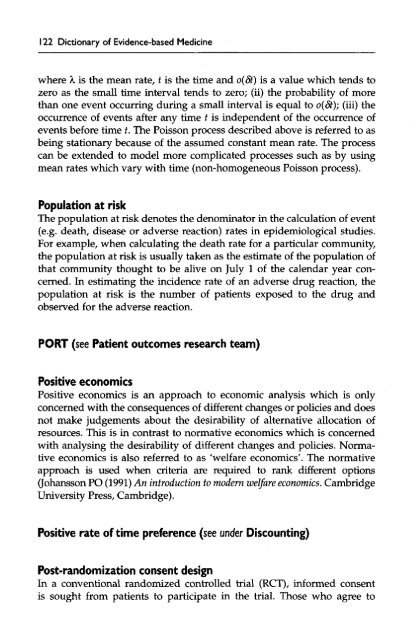Dictionary of Evidence-based Medicine.pdf
Dictionary of Evidence-based Medicine.pdf
Dictionary of Evidence-based Medicine.pdf
Create successful ePaper yourself
Turn your PDF publications into a flip-book with our unique Google optimized e-Paper software.
122 <strong>Dictionary</strong> <strong>of</strong> <strong>Evidence</strong>-<strong>based</strong> <strong>Medicine</strong><br />
where A, is the mean rate, t is the time and o(St) is a value which tends to<br />
zero as the small time interval tends to zero; (ii) the probability <strong>of</strong> more<br />
than one event occurring during a small interval is equal to o(St); (iii) the<br />
occurrence <strong>of</strong> events after any time t is independent <strong>of</strong> the occurrence <strong>of</strong><br />
events before time t. The Poisson process described above is referred to as<br />
being stationary because <strong>of</strong> the assumed constant mean rate. The process<br />
can be extended to model more complicated processes such as by using<br />
mean rates which vary with time (non-homogeneous Poisson process).<br />
Population at risk<br />
The population at risk denotes the denominator in the calculation <strong>of</strong> event<br />
(e.g. death, disease or adverse reaction) rates in epidemiological studies.<br />
For example, when calculating the death rate for a particular community,<br />
the population at risk is usually taken as the estimate <strong>of</strong> the population <strong>of</strong><br />
that community thought to be alive on July 1 <strong>of</strong> the calendar year concerned.<br />
In estimating the incidence rate <strong>of</strong> an adverse drug reaction, the<br />
population at risk is the number <strong>of</strong> patients exposed to the drug and<br />
observed for the adverse reaction.<br />
PORT (see Patient outcomes research team)<br />
Positive economics<br />
Positive economics is an approach to economic analysis which is only<br />
concerned with the consequences <strong>of</strong> different changes or policies and does<br />
not make judgements about the desirability <strong>of</strong> alternative allocation <strong>of</strong><br />
resources. This is in contrast to normative economics which is concerned<br />
with analysing the desirability <strong>of</strong> different changes and policies. Normative<br />
economics is also referred to as 'welfare economies'. The normative<br />
approach is used when criteria are required to rank different options<br />
(Johansson PO (1991) An introduction to modern welfare economics. Cambridge<br />
University Press, Cambridge).<br />
Positive rate <strong>of</strong> time preference (see under Discounting)<br />
Post-randomization consent design<br />
In a conventional randomized controlled trial (RCT), informed consent<br />
is sought from patients to participate in the trial. Those who agree to










